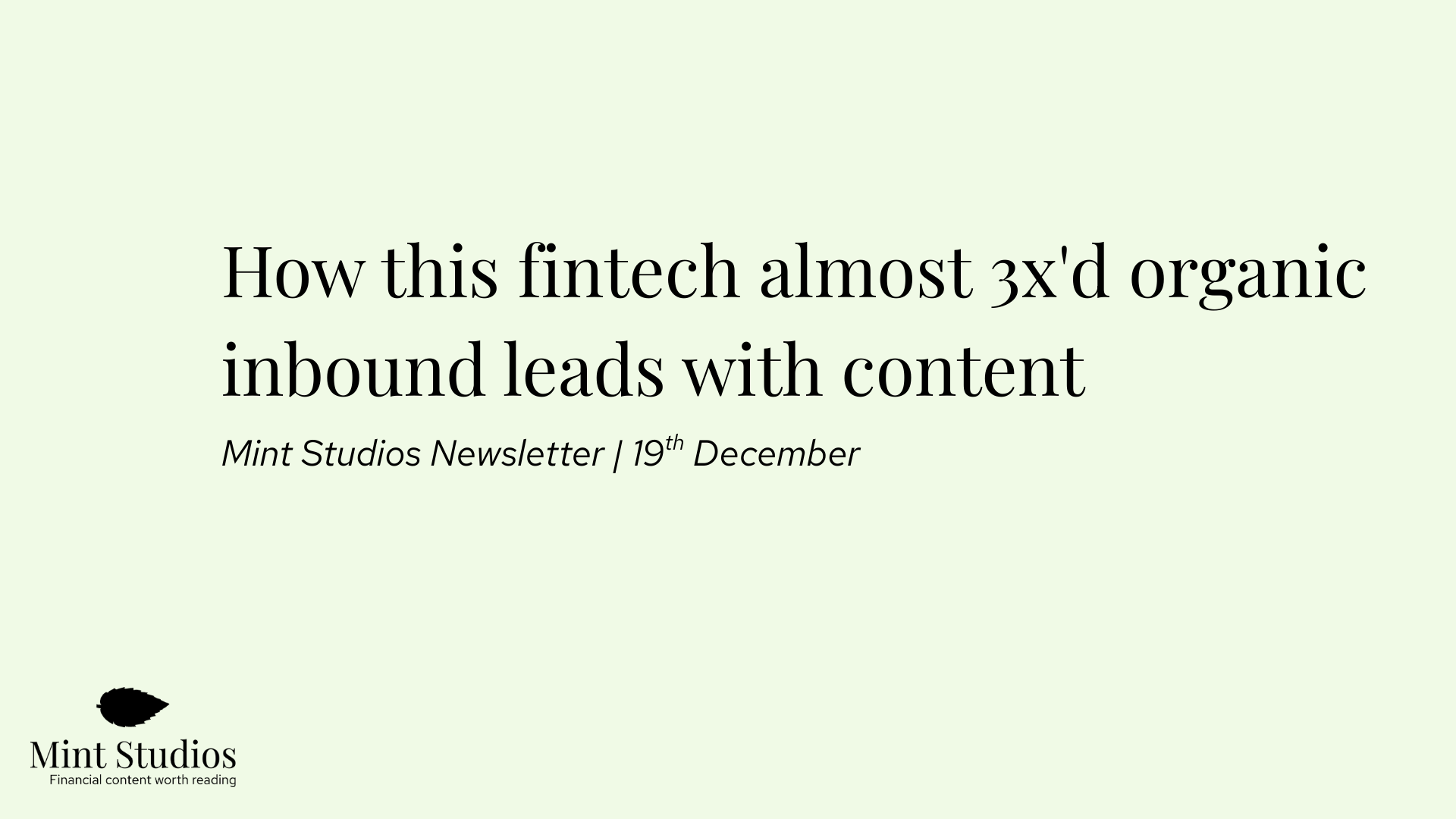Most fintech companies – most companies, really – underuse their blog.
The word “blog” has a negative connotation: one of a “blogger”, who writes about their feelings and day to day life.
But the modern website blog is completely different. If done correctly, a website blog can have a big impact on your bottom line.
In fact, it can even be your primary driver for growth, recruitment and branding. It can help you acquire customers, position yourself as an expert and help advance your mission of financial education.
If you work for a fintech company that’s focused on revenue, you’ll want to make the most of your blog.
Note: every month we send out a newsletter with our latest articles and content marketing tips for those in fintech. Sign up now to get it in your inbox.
What can you do with your blog?
Most company blogs publish product and company updates and press releases. Although that’s totally fine and valid, there is a huge missed opportunity to do more with your blog.
This is especially true in the B2B space, where it’s even more important to demonstrate expertise and authority.
Here’s what you could be doing with your blog:
- Educate prospects for sales enablement
Mistake: believing that blog content is only for educating beginners.
A very common mistake we see is for companies to treat the blog as a “nice-to-have”, purely used for brand awareness purposes and to write about lifestyle topics. But more and more buyers than ever prefer reading through a website and doing their own research before reaching out. Would you rather they read an article titled “Top payment trends in 2023” or something more like “When and how to use a direct debit API”?
They’ll get a much better first impression if your blog content features in-depth, advanced content written for the right audience.
If you have a large sales team, then it’s likely you use collateral that you use throughout the sale. These could be developer documents, one sheets, diagrams and guides. Why not repurpose some of those and turn them into blog posts?
Don’t be afraid to write niche blog content that talks about your product and topic in-depth. Here are some examples of topis that the fintech company Argyle cover on their blog:


These are not beginner topics for a beginner audience. It’s clearly for their target audience: product managers, Heads of Payment and COOs.
2. Hire team members
Mistake: creating blog content that only focuses on sales.
We’ve heard from at least two fintech companies that blog content focused on hiring has helped tremendously with getting high quality candidates when hiring.
Moov asks each person they hire to write a “Why I joined Moov” article. This has been a major driver in hiring high quality team members.

Tilled is another fintech company that has totally embraced content. They’ve never had to use a recruiter and their average time to hire is 27 days. They post a lot of content about their culture, and their CEO publishes a lot on their LinkedIn.
Read more about their journey in this case study: How This Payments Company Gets 75% of Leads Inbound and a 59% Close Rate with Content Marketing
Asking team members to write about why they joined the company (you can interview, then write) and then publishing on the blog will help immensely with recruitment.
3. Position your company as an expert
Mistake: write generic thought leadership content that has been outsourced to a writer who is not an expert on the topic.Every time we chat to a fintech company and ask about their goals, nearly all of them say that in a few years time they want their company to be well known in the space and to be known as thought leaders.
The amazing thing about content, is that it’s a marketing channel that empowers the company and the customer. The customer, because they are educated. The company, because you are seen to be knowledgeable and an expert.
Being the number one in your industry is an excellent goal: but it won’t happen if you write content like this:
This doesn’t position you as an expert. For two reasons:
- Few people will read. So many companies write about predictions every year, and it’s generally copycat content.
- The content itself doesn’t demonstrate expertise. The content of these articles is often generic, re-written from white papers on the same topic. They aren’t truly based on expertise.
If you want to create blog content that positions you as an expert, you have to do this carefully. Ideally, you produce in-depth, expert-based content on your blog, and work together with a PR agency that can help you get it to the right publications.
When we talk about thought leadership, we mean:
- It’s has a clearly differentiated stance (perhaps even polarising).
- It’s actionable (in some way, it’s helpful).
- It’s expert based (based on an interview with an expert).
However, most thought leadership is this:


In our opinion, this is not thought leadership. It’s generic content that has been rewritten from other sources.
It’s hard to find companies that do thought leadership well. The way we help fintech companies is by creating Bottom of the Funnel content (see below) that is based on interviews with experts. That way, we get the best of both worlds: content that acquires customers and also positions the company as an expert. Here are some examples of content we’ve written:
- Why are Australian fintechs being de-banked and what can they do about it?
- Direct Debit API: How to set one up (and when to use one)
- Multi-party payments: How they work and when to implement them
If you really want to create excellent thought leadership content, you need to have someone on your team who has strong opinions and thoughts. Then ask someone to interview them, write and publish. That way it’s real thought leadership content coming directly from your company.
4. Acquire customers
Mistake: believing that content is only for brand awareness and can’t be used for customer acquisition.
Yes, you can generate leads and acquire customers with your blog content. The effectiveness might depend on the distribution channel you choose (email, SEO, ads, etc). What we’ve found works best for B2B fintech companies is to generate leads by ranking for highly targeted, bottom of the funnel keywords using SEO.
The key is in our methodology:
- Create content targeting people who are close to buying (bottom of the funnel) and would be looking up solutions to their problems on Google.
- Create content for their level of expertise (so not for beginners).
- Create content based on interviews with experts.
- Track the results so you can prove the results.
We go into more detail in this article: The Huge Opportunity for Content Marketing in the Payments Industry
With this approach, we’re able to bring in customers worth $100k+ for high ticket B2B payment companies. Most companies are using SEO to rank their product pages. But in the B2B world, you can use a combination of content and SEO to rank for incredibly targeted keywords that only your target market would be buying.
You can learn more about what we’ve seen works in these case studies:
- How Many Leads Can You Generate with Content Marketing?
- Can Blog Content Bring in SQLs for Enterprise B2B? Yes, and Here's How
The great thing about the blog is that it’s easy to set up, and the barrier to entry is low. The hard part is that it requires collaboration from the sales team, a content person and the product person.
However, when done correctly, it can have a huge impact on the bottom line. So why not make the most of it?











